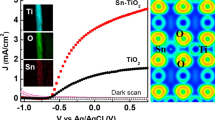Abstract
Experimental studies have shown the production of hydrogen through a photocatalytic water splitting process using a titanium dioxide nanotube (TiO2NT) as a photoelectrode. In this study, a theoretical model of pristine and nitrogen-doped TiO2NT based on a TiO2 anatase (101) surface is presented. Spin unrestricted density functional theory calculations were performed to provide a detailed description of the geometries, electronic properties, and adsorption of water (H2O) on pristine and N-doped TiO2NT. The calculations show that doping with N will improve the photocatalytic properties of TiO2NT in two ways: First, the energy barrier of the dissociation reaction of water into hydroxyl radical and hydrogen atom is reduced; and second, the defect-induced states above the valence band lowers the band gap which will result in enhanced visible-light-driven photoactivity. Based on the position of the Fermi level relative to the defect induced energy levels, an optimal doping concentration of around 1.4% is proposed, which is in good agreement with experimental results. This study provides an atomic/molecular level understanding of the photocatalytic water splitting process and may serve as a groundwork for the rational design of more efficient photocatalysts.
Similar content being viewed by others
References
J. Andrews and B. Shabani, Int. J. Hydrog. Energy (2012). doi:10.1016/j.ijhydene.2011.09.137.
A. Fujishima and K. Honda, Nature (1972). doi:10.1038/238037a0.
F. Xiao and B. Liu, Heterog. Photocatal. (2015). doi:10.1007/978-3-662-48719-8_5.
K. Zhu, T.B. Vinzant, N.R. Neale, and A.J. Frank, Nano Lett. (2007). doi:10.1021/nl072145a.
D. Gong, C.A. Grimes, O.K. Varghese, W. Hu, R.S. Singh, Z. Chen, and E.C. Dickey, J. Mater. Res. (2001). doi:10.1557/jmr.2001.0457.
R. Vitiello, J. Macak, A. Ghicov, H. Tsuchiya, L. Dick, and P. Schmuki, Electrochem. Commun. (2006). doi:10.1016/j.elecom.2006.01.023.
R. Beranek, J.M. Macak, M. Gärtner, K. Meyer, and P. Schmuki, Electrochim. Acta (2009). doi:10.1016/j.electacta.2008.10.063.
Y. Su, X. Zhang, M. Zhou, S. Han, and L. Lei, J. Photochem. Photobiol. A (2008). doi:10.1016/j.jphotochem.2007.08.002.
L. Sang, Z. Zhang, and C. Ma, Int. J. Hydrog. Energy (2011). doi:10.1016/j.ijhydene.2011.01.071.
X. Pan, Q. Cai, W. Chen, G. Zhuang, X. Li, and J. Wang, Comput. Mater. Sci. (2013). doi:10.1016/j.commatsci.2012.09.006.
H. Liu and K. Tan, Comput. Theor. Chem. (2012). doi:10.1016/j.comptc.2012.04.004.
W. Li, Phys. Status Solidi RRL (2014). doi:10.1002/pssr.201409365.
S. Piskunov, O. Lisovski, J. Begens, D. Bocharov, Y.F. Zhukovskii, M. Wessel, and E. Spohr, J. Phys. Chem. C (2015). doi:10.1021/acs.jpcc.5b03691.
O. Lisovski, A. Chesnokov, S. Piskunov, D. Bocharov, Y.F. Zhukovskii, M. Wessel, and E. Spohr, Mater. Sci. Semicond. Process. (2016). doi:10.1016/j.mssp.2015.09.003.
Q. Xie, Q. Meng, G. Zhuang, J. Wang, and X. Li, Int. J. Quantum Chem. (2011). doi:10.1002/qua.23269.
W. Kohn and L.J. Sham, Phys. Rev. (1965). doi:10.1103/physrev.140.a1133.
K.I. Rojas, A.R.C. Villagracia, and N.B. Arboleda Jr, Mater.␣Res. Express (2016). doi:10.1088/2053-1591/3/11/115015.
J.I.G. Enriquez and A.R.C. Villagracia, Int. J. Hydrog. Energy (2016). doi:10.1016/j.ijhydene.2016.06.035.
J.P. Perdew, K. Burke, and M. Ernzerhof, Phys. Rev. Lett. (1996). doi:10.1103/physrevlett.77.3865.
B. Delley, J. Phys. Chem. (1996). doi:10.1021/jp952713n.
B. Delley, Phys. Rev. B (2002). doi:10.1103/physrevb.66.155125.
H.J. Monkhorst and J.D. Pack, Phys. Rev. B (1976). doi:10.1103/physrevb.13.5188.
J.P. Perdew, Int. J. Quantum Chem. (1986). doi:10.1002/qua.560300314.
C. Kittel, Introduction to Solid State Physics, vol. 162 (New York: Wiley, 1966), pp. 205–208.
T. Lindgren, J.M. Mwabora, E. Avendaño, J. Jonsson, A. Hoel, C. Granqvist, and S. Lindquist, J. Phys. Chem. B (2003). doi:10.1021/jp027345j.
R. Asahi, Science (2001). doi:10.1126/science.1061051.
H. Cheng, Y. Chen, W. Wu, and C. Hsu, Mater. Sci. Eng. B (2011). doi:10.1016/j.mseb.2011.02.001.
J. Rossmeisl, A. Logadottir, and J. Nørskov, Chem. Phys. (2005). doi:10.1016/j.chemphys.2005.05.038.
Q. Meng, J. Wang, Q. Xie, H. Dong, and X. Li, Catal. Today (2011). doi:10.1016/j.cattod.2010.11.086.
Acknowledgements
We would like to express our gratitude to the Department of Science and Technology of the Philippines for their financial support. This study would not be possible without the assistance from the Physics of Department of De La Salle University through the Computational Materials Design Research Group and the High Performance Computing Laboratory of De La Salle University.
Author information
Authors and Affiliations
Corresponding author
Rights and permissions
About this article
Cite this article
Enriquez, J.I.G., Moreno, J.L.V., David, M.Y. et al. DFT Investigation on the Electronic and Water Adsorption Properties of Pristine and N-Doped TiO2 Nanotubes for Photocatalytic Water Splitting Applications. J. Electron. Mater. 46, 3592–3602 (2017). https://doi.org/10.1007/s11664-017-5342-y
Received:
Accepted:
Published:
Issue Date:
DOI: https://doi.org/10.1007/s11664-017-5342-y




